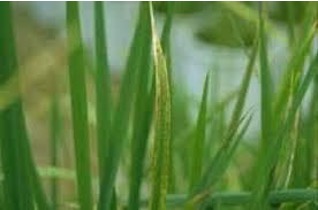Manganese toxicity affects the plants’ metabolic process such as enzyme activities and organic compounds. This can lead to sterility in plants.
Manganese toxicity is relatively rare, especially in irrigated rice systems and rarely occurs in lowland rice. It can occur in the following soils:
- acid upland soils (pH <5.5) ; Mn toxocity oftem occurs with Aluminum (Al) toxicity
- lowland soils containing large amounts of easily reducible Mn
- acid sulfate soils
- area affected by Mn mining (e.g Japan , etc)
How to identify (symptoms)
- yellowish brown spots between leaf veins, extending to the whole interveinal area
- brown spots on veins of lower leaf blades and leaf sheaths
- leaf tips dried out 8 weeks after planting
- cholorsis of younger (upper) leaves
- stunted plants with reduced tillering

How to manage
Manganese toxicity is not very common in rice. Where possible, the general management options for Mn toxicity are:
- Balance the use of fertilizers (NPK or NPK +lime) to avoid nutrient stress as asource of Mn toxicity
- Apply sufficient Potassium(K) fertilizer
- Apply lime on acid soils to reduce the concentration of active Mn.
- Do not apply excessive amounts of organic matter (manure, straw) on soils containing large concentrations of Mn and organic matter and on poorly drained soils.
- Recycle straws or ash to replenish Silicon (Si) and K removed from the field


